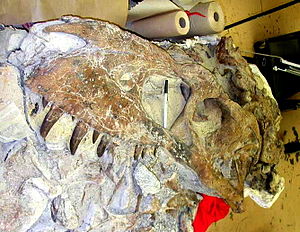Bistahieversor
| Bistahieversor | ||||||||||
|---|---|---|---|---|---|---|---|---|---|---|

Bistahieversor's skull during dissection |
||||||||||
| Temporal occurrence | ||||||||||
| Upper Chalk (Upper Campanium ) | ||||||||||
| 76.4 to 72 million years | ||||||||||
| Locations | ||||||||||
| Systematics | ||||||||||
|
||||||||||
| Scientific name | ||||||||||
| Bistahieversor | ||||||||||
| Carr & Williamson , 2010 |
Bistahieversor is a dinosaur thatbelongedto the Tyrannosauroidea and was first described in2010. The only species is Bistahieversor sealeyi .
The genus was named after the Bisti Wilderness Area in New Mexico , where its fossils were found, and the Latin word for destroyer ( eversor ). The specific epithet sealeyi honors Paul Sealey, who found the holotype specimen. Bistahieversor lived in the Upper Cretaceous (late Campanium).
The holotype specimen is an anatomically preserved skull with a skeleton. In addition, a fragmentary skull, the skeleton of a young animal and part of a right tear bone from a third specimen were found. Only the skulls were examined for the initial description. Its total length is estimated at 8 m.
features
The skull of the holotype specimen is 107 centimeters long and 31 centimeters high in front of the orbit (eye socket). In contrast to other tyrannosaurs, Bistahieversor had an additional skull opening above the eyes, a keel along the lower jaw and more teeth than Tyrannosaurus rex . In his upper jaw he showed a clear tooth gap ( dichotomy ).
The basal, flat-headed tyrannosaurs of the Jurassic and Lower Cretaceous probably caught their prey primarily with their forelegs, a function that was later assumed by the strong jaws of the more advanced tyrannosaurs of the Upper Cretaceous. The scientists therefore assume that the bistahieversor, which is also highly skulled, only had small, reduced front limbs. However, they have not yet been exposed.
Bistahieversor is regarded as an indication of the thesis that the high-headed tyrannosaurs with very strong jaws developed only in western North America, which was separated from the eastern part of the continent by the Western Interior Seaway , a shallow sea. East North American tyrannosaurs like Appalachiosaurus retained the original low-snout feature.
literature
- Thomas D. Carr, Thomas E. Williamson: Bistahieversor sealeyi, gen. Et sp. nov., a new tyrannosauroid from New Mexico and the origin of deep snouts in Tyrannosauroidea. In: Journal of Vertebrate Paleontology. Vol. 30, No. 1, ISSN 0272-4634 , 2010, pp. 1-16, doi : 10.1080 / 02724630903413032 .
Individual evidence
- ^ A b Gregory S. Paul : The Princeton Field Guide To Dinosaurs. Princeton University Press, Princeton NJ et al. 2010, ISBN 978-0-691-13720-9 , p. 103, online ( memento of the original of July 13, 2015 in the Internet Archive ) Info: The archive link has been inserted automatically and has not yet been checked. Please check the original and archive link according to the instructions and then remove this notice. .